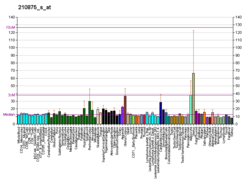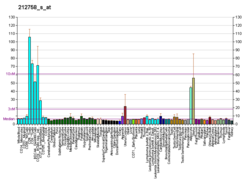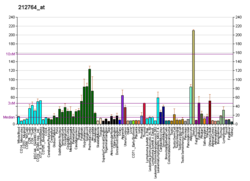ZEB1
Zinc finger E-box-binding homeobox 1 is a protein that in humans is encoded by the ZEB1 gene.[5][6][7]
ZEB1 (previously known as TCF8) encodes a zinc finger and homeodomain transcription factor that represses T-lymphocyte-specific IL2 gene expression by binding to a negative regulatory domain 100 nucleotides 5-prime of the IL2 transcription start site.[7][6] ZEB1 and its mammalian paralog ZEB2 belongs to the Zeb family within the ZF (zinc finger) class of homeodomain transcription factors. ZEB1 protein has 7 zinc fingers and 1 homeodomain.[8] The structure of the homeodomain is shown on the right.
Clinical significance
Mutations of the gene are linked to posterior polymorphous corneal dystrophy 3. ZEB1 downregulates E-cadherin and induces epithelial to mesenchymal transition in breast and other carcinomas.[9] A recent study suggested its contributing role in lung cancer invasiveness and metastasis development.[10] ZEB1 contributes to bone-specific metastasis of breast carcinomas by inactivating BMP signaling through the induction of the expression of BMP-inhibitors.[citation needed]
References
- ^ a b c GRCh38: Ensembl release 89: ENSG00000148516 – Ensembl, May 2017
- ^ a b c GRCm38: Ensembl release 89: ENSMUSG00000024238 – Ensembl, May 2017
- ^ "Human PubMed Reference:". National Center for Biotechnology Information, U.S. National Library of Medicine.
- ^ "Mouse PubMed Reference:". National Center for Biotechnology Information, U.S. National Library of Medicine.
- ^ Williams TM, Montoya G, Wu Y, Eddy RL, Byers MG, Shows TB (September 1992). "The TCF8 gene encoding a zinc finger protein (Nil-2-a) resides on human chromosome 10p11.2". Genomics. 14 (1): 194–6. doi:10.1016/S0888-7543(05)80307-6. PMID 1427828.
- ^ a b Williams TM, Moolten D, Burlein J, Romano J, Bhaerman R, Godillot A, Mellon M, Rauscher FJ, Kant JA (December 1991). "Identification of a zinc finger protein that inhibits IL-2 gene expression". Science. 254 (5039): 1791–4. Bibcode:1991Sci...254.1791W. doi:10.1126/science.1840704. PMID 1840704.
- ^ a b "Entrez Gene: ZEB1 zinc finger E-box binding homeobox 1".
- ^ Bürglin TR, Affolter M (July 2016). "Homeodomain proteins: an update". Chromosoma. 125 (3): 497–521. doi:10.1007/s00412-015-0543-8. PMC 4901127. PMID 26464018.
- ^ Eger A, Aigner K, Sonderegger S, Dampier B, Oehler S, Schreiber M, Berx G, Cano A, Beug H, Foisner R. (March 2005). "DeltaEF1 is a transcriptional repressor of E-cadherin and regulates epithelial plasticity in breast cancer cells". Oncogene. 31, 24 (14): 2375–85. doi:10.1038/sj.onc.1208429. PMID 15674322.
{{cite journal}}: CS1 maint: multiple names: authors list (link) - ^ Liu W, Huang YJ, Liu C, Yang YY, Liu H, Cui JG, Cheng Y, Gao F, Cai JM, Li BL (April 2014). "Inhibition of TBK1 attenuates radiation-induced epithelial-mesenchymal transition of A549 human lung cancer cells via activation of GSK-3β and repression of ZEB1". Laboratory Investigation; A Journal of Technical Methods and Pathology. 94 (4): 362–70. doi:10.1038/labinvest.2013.153. PMID 24468793.
Further reading
- Franklin AJ, Jetton TL, Shelton KD, Magnuson MA (October 1994). "BZP, a novel serum-responsive zinc finger protein that inhibits gene transcription". Molecular and Cellular Biology. 14 (10): 6773–88. doi:10.1128/MCB.14.10.6773. PMC 359208. PMID 7935395.
- Watanabe Y, Kawakami K, Hirayama Y, Nagano K (December 1993). "Transcription factors positively and negatively regulating the Na,K-ATPase alpha 1 subunit gene". Journal of Biochemistry. 114 (6): 849–55. doi:10.1093/oxfordjournals.jbchem.a124267. PMID 8138542.
- Ikeda K, Halle JP, Stelzer G, Meisterernst M, Kawakami K (January 1998). "Involvement of negative cofactor NC2 in active repression by zinc finger-homeodomain transcription factor AREB6". Molecular and Cellular Biology. 18 (1): 10–8. doi:10.1128/mcb.18.1.10. PMC 121442. PMID 9418848.
- Turner J, Crossley M (September 1998). "Cloning and characterization of mCtBP2, a co-repressor that associates with basic Krüppel-like factor and other mammalian transcriptional regulators". The EMBO Journal. 17 (17): 5129–40. doi:10.1093/emboj/17.17.5129. PMC 1170841. PMID 9724649.
- Postigo AA, Dean DC (June 1999). "ZEB represses transcription through interaction with the corepressor CtBP". Proceedings of the National Academy of Sciences of the United States of America. 96 (12): 6683–8. Bibcode:1999PNAS...96.6683P. doi:10.1073/pnas.96.12.6683. PMC 21975. PMID 10359772.
- Hlubek F, Löhberg C, Meiler J, Jung A, Kirchner T, Brabletz T (April 2001). "Tip60 is a cell-type-specific transcriptional regulator". Journal of Biochemistry. 129 (4): 635–41. doi:10.1093/oxfordjournals.jbchem.a002901. PMID 11275565.
- Locklin RM, Riggs BL, Hicok KC, Horton HF, Byrne MC, Khosla S (December 2001). "Assessment of gene regulation by bone morphogenetic protein 2 in human marrow stromal cells using gene array technology". Journal of Bone and Mineral Research. 16 (12): 2192–204. doi:10.1359/jbmr.2001.16.12.2192. PMID 11760832. S2CID 25397480.
- Shaheduzzaman S, Krishnan V, Petrovic A, Bittner M, Meltzer P, Trent J, Venkatesan S, Zeichner S (2002). "Effects of HIV-1 Nef on cellular gene expression profiles". Journal of Biomedical Science. 9 (1): 82–96. doi:10.1007/BF02256581. PMID 11810028.
- Guaita S, Puig I, Franci C, Garrido M, Dominguez D, Batlle E, Sancho E, Dedhar S, De Herreros AG, Baulida J (October 2002). "Snail induction of epithelial to mesenchymal transition in tumor cells is accompanied by MUC1 repression and ZEB1 expression". The Journal of Biological Chemistry. 277 (42): 39209–16. doi:10.1074/jbc.M206400200. PMID 12161443.
- Costantino ME, Stearman RP, Smith GE, Darling DS (August 2002). "Cell-specific phosphorylation of Zfhep transcription factor". Biochemical and Biophysical Research Communications. 296 (2): 368–73. doi:10.1016/S0006-291X(02)00880-X. PMC 3682420. PMID 12163027.
- Postigo AA (May 2003). "Opposing functions of ZEB proteins in the regulation of the TGFbeta/BMP signaling pathway". The EMBO Journal. 22 (10): 2443–52. doi:10.1093/emboj/cdg225. PMC 155983. PMID 12743038.
- Postigo AA, Depp JL, Taylor JJ, Kroll KL (May 2003). "Regulation of Smad signaling through a differential recruitment of coactivators and corepressors by ZEB proteins". The EMBO Journal. 22 (10): 2453–62. doi:10.1093/emboj/cdg226. PMC 155984. PMID 12743039.
- Dillner NB, Sanders MM (January 2004). "Transcriptional activation by the zinc-finger homeodomain protein delta EF1 in estrogen signaling cascades". DNA and Cell Biology. 23 (1): 25–34. doi:10.1089/104454904322745907. PMID 14965470.
- Beausoleil SA, Jedrychowski M, Schwartz D, Elias JE, Villén J, Li J, Cohn MA, Cantley LC, Gygi SP (August 2004). "Large-scale characterization of HeLa cell nuclear phosphoproteins". Proceedings of the National Academy of Sciences of the United States of America. 101 (33): 12130–5. Bibcode:2004PNAS..10112130B. doi:10.1073/pnas.0404720101. PMC 514446. PMID 15302935.
- Shimizu S, Krafchak C, Fuse N, Epstein MP, Schteingart MT, Sugar A, Eibschitz-Tsimhoni M, Downs CA, Rozsa F, Trager EH, Reed DM, Boehnke M, Moroi SE, Richards JE (November 2004). "A locus for posterior polymorphous corneal dystrophy (PPCD3) maps to chromosome 10". American Journal of Medical Genetics. Part A. 130A (4): 372–7. doi:10.1002/ajmg.a.30267. PMC 1249494. PMID 15384081.
- Eger A, Aigner K, Sonderegger S, Dampier B, Oehler S, Schreiber M, Berx G, Cano A, Beug H, Foisner R (March 2005). "DeltaEF1 is a transcriptional repressor of E-cadherin and regulates epithelial plasticity in breast cancer cells". Oncogene. 24 (14): 2375–85. doi:10.1038/sj.onc.1208429. PMID 15674322.
External links









